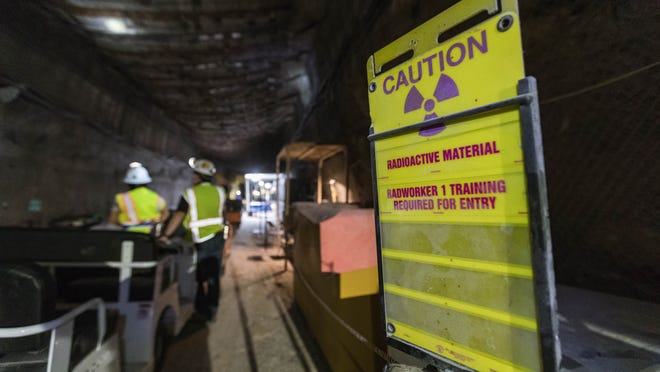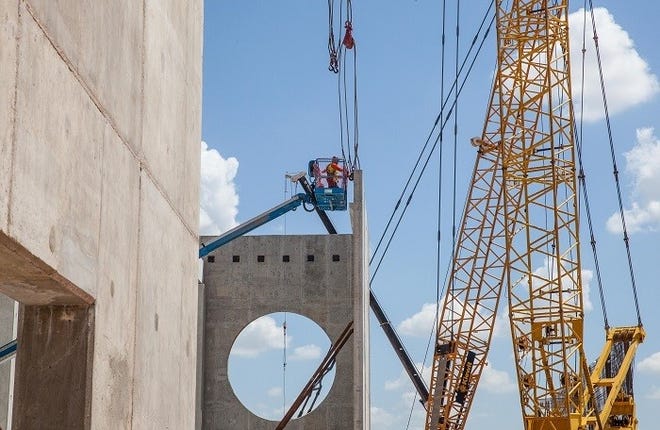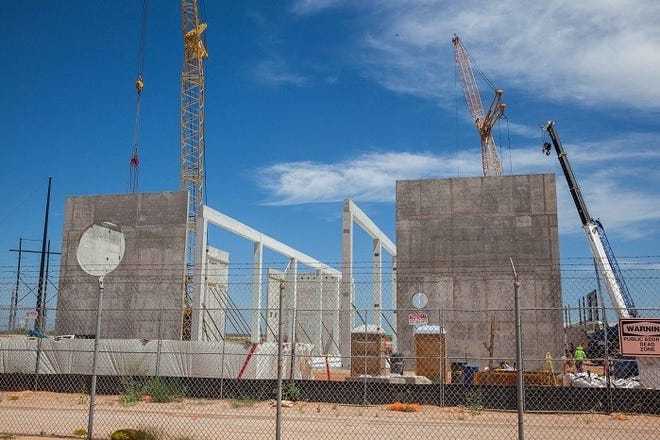
A major section of the ongoing $288 million rebuild of the Waste Isolation Pilot Plant’s ventilation system was nearing completion, moving the project toward its goal of going into service by 2025.
WIPP’s underground airflow was restricted in 2014 after an accidental radiological release, meaning work in the nuclear waste repository was confined to either mining more space for the waste or emplacing it in disposal panels – but not at the same time.
That could put pressure on plans to time mining of the eighth panel to hold the waste with filling up the seventh.
More:Texas votes to ban high-level nuclear waste storage. Could New Mexico do the same?
To increase airflow and allow the work to occur simultaneously, WIPP embarked on the project to rebuild its air system boosting available air for workers to breathe from about 170,000 cubic feet per minute (cfm) to 540,000 cfm.
The project was dubbed the Safety Significant Confinement Ventilation System (SSCVS) and was reported as the largest capital project at WIPP in 30 years.
Part of the rebuild was the Salt Reduction Building which will remove salt from the air as it is pumped into the surface.
More:WIPP: New panels to dispose of nuclear waste
It will serve as the first step of the SSCVS’ air filtration where air is drawn through the 25,000 square foot building and then sent to the New Filter Building where air is pulled through high efficiency particulate air (HEPA) filters.

At the Salt Reduction Building, water misters and filters are used to drop airborne salt our of exhaust steam from the underground and then sent to the filter building by 1,000 horsepower fans.
There, 22 sets of filters remove other contaminants before the air is released in a 125-foot exhaust stack.
More:NRC: Court lacks authority in New Mexico lawsuit against nuclear waste site
The U.S. Department of Energy announced the building was ahead of schedule due to the use of precast walls built in San Antonio, reducing build time as workers don’t have to wait for concrete to dry.
The walls are transported to the WIPP site after being constructed by the Tindell Corporation via flatbed trailers and then lifted into place by a 250-ton crane.
There were 32 wall panels between each of the building’s 41-foot corners, with each panel weighting about 47,000 pounds.
More:Nuclear waste facility near Carlsbad sees COVID-19 surge as infections rise in New Mexico
Four other panels will be installed later to leave a needed gap for moving equipment into the site.
When complete, the building will also include 64 roof panels weighing about 34,000 pound each, with 15 roof beams at about 24,000 pounds each along with 18 support columns weighting about 20,000 pound each.
Steven Smith, capital infrastructure manager at Nuclear Waste Partnership – WIPP’s primary operations contractor – said work on the Salt Reduction Building put the SSCVS project ahead of schedule by more than two weeks.
More:Pushing ahead: Ongoing work at Waste Isolation Pilot Plant advances nuclear waste mission
It was delayed when a subcontract with Carlsbad-based Critical Applications Alliance to build the system was terminated last year and re-awarded in April to Denver-based The Industrial Company (TIC) – pushing back the project from 2022 to 2025 and increasing the construction cost from $135 million to $163 million.

“To date, with the initiation of work under this new main build subcontractor (TIC), the project is 16 days ahead of schedule, with any quality issues being quickly resolved,” he said. “This work is truly a collaborative team effort between the NWP SSCVS project team and TIC.”
While the SSCVS is being completed, WIPP officials planned to restart a ventilation fan decommissioned after the 2014 events after it was tested and found any release of radiation from the fan’s use would be minimal.
More:Feds see no problems with nuclear waste storage in West Texas, New Mexico despite concerns
A separate project to build a new shaft to serve as an air intake at the site was ongoing, with a modification to WIPP’s permit with the New Mexico Environment Department (NMED) pending to allow its construction and operation.
In a statement of support for the fan restart filed by Rick Fuentes, president of the United Steelworkers chapter that represents waste handlers at WIPP, he said increased airflow was needed to ensure worker safety at the facility.
“The additional airflow will improve air quality for employees working in the underground, which will allow us to better support ground control, waste emplacement, and mining activities,” Fuentes wrote.
Adrian Hedden can be reached at 575-618-7631, achedden@currentargus.com or @AdrianHedden on Twitter.






